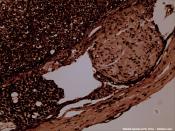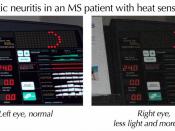Introduction
Multiple sclerosis is the most common human demyelinating disease of the central nervous system, and the most frequent cause of chronic neurological disability in young adults. Symptoms of the disease usually appear in the 20 ?40 age group, but the most common age of onset is between 31 and 33 years of age, a time when most are in their prime and beginning careers or starting families. Symptoms rarely present before the age of 15, and after the age of 60.
When a person is under attack from MS, an inflammatory response is evoked in the white matter of the central nervous system. This inflammation occurs in random patches called ?laques? Subsequent to the plaque formation, myelin (a fatty covering which surrounds and insulates nerve cell fibres in the brain and spinal cord) is destroyed. As myelin is responsible for facilitating the smooth and high-speed transmission of the impulse along the axon, electrochemical messaging between the brain, spinal cord, and indeed the rest of the body will be interrupted when it is damaged.
This interruption varies from slowing the propagation of the impulse, to completely blocking it, depending on the extent of the damage. This can lead to diminishment or complete loss of function for the patient.
MS can produce lesions throughout the entire CNS, but certain areas such as the optic nerve, brainstem, spinal cord, and periventricular regions, have been identified as particularly vulnerable. These lesions may be broadly divided into two groups, acute and chronic.
Acute lesions by their very nature are inflammatory, and exhibit infiltration of cells associated with inflammation, namely T- and B-lymphocytes, and macrophages. The macrophages will often contain the debris of the myelin broken down from the sheaths. The degree of inflammation is dependant upon the extent of axonal loss. This will...



The aetiology, current and potential treatment of multiple sclerosis
this was an excellent essay!!!
1 out of 1 people found this comment useful.